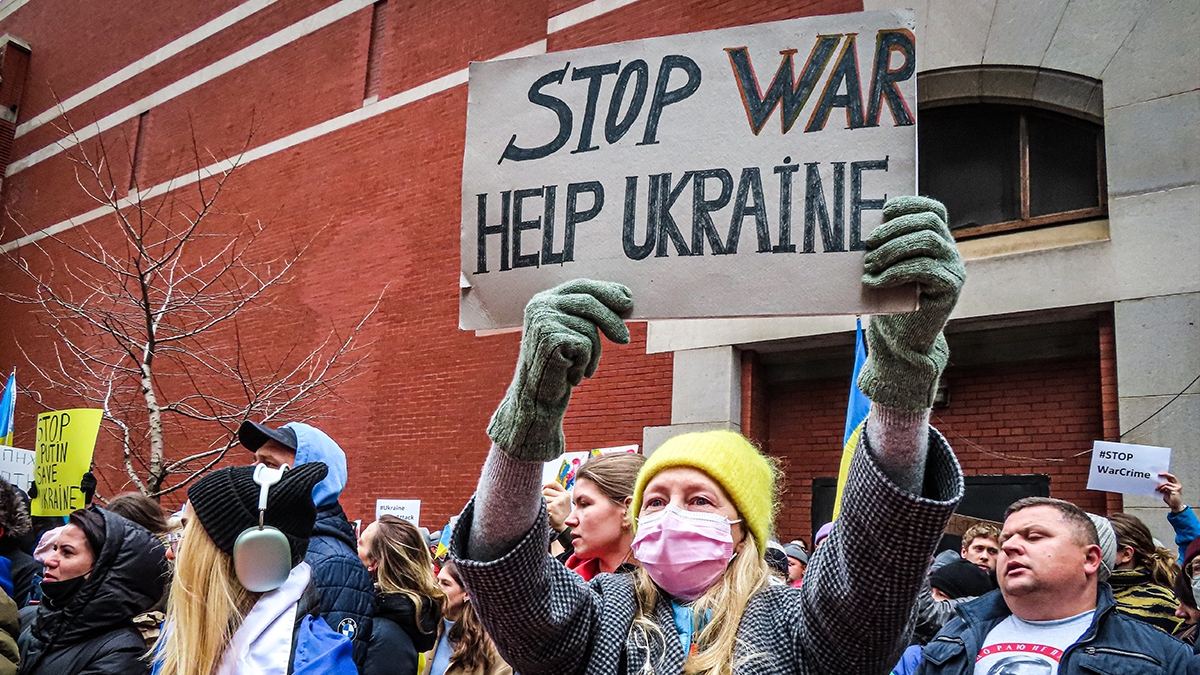For the last week I have watched, as countless others have, the scenes which have unfolded across Europe and in Ukraine. Watching in horror as the Russian armies gathered at the border, then in disbelief as President Putin gave the order to commence the invasion of Ukraine.
With the advent of social media two key points have emerged which we should give credence to when considering the ongoing conflict.
The capacity to access social media via our phones, watches, tablets, computers, and indeed our televisions has provided us with the ability to immerse ourselves in activity across the world at the touch of a button. Never in recent history has there been a conflict that has felt so immediate. People can observe the unfolding horrors of war right before their eyes, often taking place in real time.
The second point is that as social media has grown and social media streams have evolved, trust in traditional news and media outlets has waned. There has never been a time in history in which we as truth-seekers must disseminate the information which we are presented with and find ways to filter the fake news from the real. This is an onerous task, however, given the nature of the events that are unfolding, it is something we must engage in.
As the recent days have passed, I have been very grateful to have been able to avail of the input provided by Professor Ciaran Martin of the Blavatnik School of Government at the University of Oxford. Professor Martin is also the founding head of the National Cyber Security Centre and someone who as CDPB Fellows we were privileged to hear from during the course of the Fellowship Programme and our time spent in Oxford University. Professor Martin has been able to disseminate the information which is flooding our social media streams and present it in such a way that is informed, accessible and understandable.
The unfolding conflict will undoubtedly be a point of conversation as we question the legality and morality of war. We need to be armed with the facts to make an informed decision on this. While social media has presented us with the ability to immediately witness the war, the immediate picture is all we see.
What are the possible outcomes of the ensuing conflict? President Putin may manage to conquer Ukraine militarily and install his own government. Ukraine may manage to hold out and stave off the invasion. Personally, I do not see this as possible for reasons which will be explained later. Regardless, there must be a long-term vision for the future of Ukraine. We are already seeing the cost of war with over 400,000 men women and children who have now been displaced from their homeland. This will create trans-generational trauma that we will not know the impact of for many years.
For one such as I who is guided by the principles of Gandhian nonviolence the last few days have been very conflicting for me. I do not accept the legality of what President Putin is engaged in. However, the greatest cause of conflict for me has been when asked about the Ukrainian response to the violence which is right at their doorstep.
I am aware that as a follower of nonviolence it is very easy for me to spell out the principles of nonviolence while I am hundreds of miles away from the ongoing conflict. It is very easy for me to say “don’t take up arms” when my home is not being bombed, or while my way of life remains unthreatened. However, this is what I have tried to do and this is what I shall try to spell out, and leave the reader to draw their own conclusion.
True nonviolence has one singular objective – to change hearts from violence to nonviolence.
Nonviolence is not passive, and it is not an act of surrender. Rather it is the supreme act in which the oppressed stands up to the aggressor not with physical violence but with soul-force. As the level of aggression increases, so too is the required nonviolent response and level of soul-force. This can be as basic as turning one’s cheek when insulted or physically hit, or the supreme act of the willingness to lay down one’s life for their cause. The means must be nonviolent, and the intention must be for the common good.

Photo by: Katie Godowski, Pexels
As the level of violence increases, so too does the level of dehumanisation perpetrate. Violence is an act of dehumanising the other so much so that we are capable of making that most ultimate and final of decisions – who lives and who dies.
We are seeing this unfold at present in Ukraine. As the Russian army has begun its onslaught of the Ukrainian people, it has become evidently clear that their military force far exceeds that of the Ukrainians, despite what arms or equipment they have received from NATO allies. Many people have commented and marvelled at the capacity of the Ukrainian people to be able to withstand the onslaught. This is true. So far. However, while Vladimir Putin brought over one hundred thousand soldiers to Ukraine, do not forget that the Russian army has around one million active-duty personnel and at least two million reserve personnel. Putin’s full force has not yet been unleashed. Let us hope and pray it is not.
Ukraine does not have the structural capacity to overcome the Russian force as a consolidated military force. Guerrilla warfare, as we know all too well here at home, somehow only ends with harming one’s own people, is messy and does not overcome the oppressor. It certainly didn’t work for the IRA.
For that is what President Putin is in this sorry tale. He is the oppressor. He has assumed the role of Dictator. While internationally the world has mostly been united in its condemnation of President Putin and have managed to arm and provide military equipment to Ukraine this will not last indefinitely. While not engaging in the conflict directly the international community has declared violence is how this invasion will end. This gives President Putin the advantage. This is the cost of war and the awful madness of war. We choose to fight a raging fire, with a smaller one, and are surprised when the raging fire engulfs the smaller one.
Our response to a process of dehumanisation, which is what war is, must be one in which we rehumanise our perspective of the oppressor. We don’t even have to begin with Vladimir Putin, but rather those we encounter on a daily basis. The average Russian soldier that is engaged in conflict is approximately 20 years of age. They are not engaged in this conflict because they hate Ukrainians. They are also victims of the dictator. See them as a person; someone with wants and needs, family and friends that they want to return home to.
So, what of negotiation? Well, President Putin is a dictator. Dictators do not care for negotiations and cannot be trusted to uphold their end of the deal. How then do we achieve a long-term peace agreement? Negotiation is not the answer. Resistance is.
As these young Russian men enter social communities in Ukraine there is capacity to resist. To recognise the shared humanity of the oppressor and the resistor. Only when communities unite as one can, they withstand such a force. As they do so, as social groups come together and unite, then this resistance becomes strong enough to withstand a military force in a nonviolent way. Then with a clear and communicated vision and strategy for the future, can de-escalation occur.
Sometimes this takes years, such as the decade required to end Communist rule of Poland. There are other times when it only takes weeks, such as Czechoslovakia in 1989. However, the longer the force of violence is used, the longer it will take to cease fire. President Volodymyr Zelenskyy has a small window to end the Ukrainian attempt to defeat President Putin’s army militarily. Efforts can then go into resisting any potential occupying Russian force and destabilise their presence in Ukraine. It is already unstable in Russia.
Now, this does not solve the overall head of the problem, President Putin himself. As a dictator he must be removed. This cannot be repeated with removing from President Putin from power with no clear idea of where to go next as in Iraq. Further, as violence is met with further violence this creates instability and fosters fear and resentment. Violence has never and will never solve the problems our world faces.
Only our capacity to see each other as humans will we achieve true peace. I hope and pray this capacity still exists in the hearts and minds of the Ukrainian and Russian people, who are now drawn into a conflict like pawns on a chessboard. Pawns sent to die in a war that was not of their making or intention. This is the awful cost of war. Resist it.
Dominic O’Reilly
Cover photo by: Matti, Pexels



